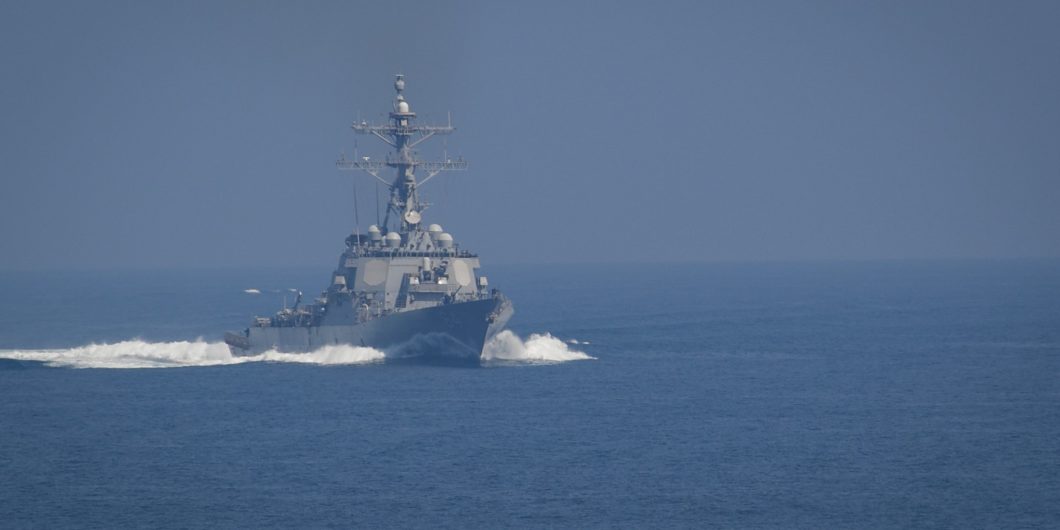Many of the traditions that Burke defended were salutary restraints on power. Conservatives shouldn't forget that America has such an inheritance, too.
The Return of Conservative Nationalism
Washington since late 2016 seems a world turned upside down with cherished norms flouted and certitudes cast aside. Donald Trump’s election marked, among other things, a vote of no confidence in post-Cold War foreign policy and those in both major parties who directed it. That popular declaration of “non serviam” shocked insiders no less than the unlikely personality who was its mouthpiece. John Ikenberry’s description of Trump as “as a hostile revisionist power… in the Oval Office, the beating heart of the Free World” captured a feeling unchanged since Foreign Affairs published it in 2017. Trump reflected not only a challenge to specific policies, but longstanding assumptions behind them. He poses a larger question about what nationalism means for an American foreign policy long shaped, if not defined, by strains of internationalist thinking.
Colin Dueck explores that question sympathetically in Age of Iron: On Conservative Nationalism. A professor of international relations at George Mason University who has advised Republican candidates on foreign policy, he operates within the overlapping worlds of academic scholarship and policy, while avoiding the groupthink that often marks reactions to Trump. Neither opponent nor apologist, he attempts to explain conservative nationalism in the United States today and set it in historical context. Liberal internationalism of the Cold War and post-Cold War eras has given way to different thinking more attuned to current problems. Borrowing from the Greek poet Hesiod, Dueck describes the new normal as an Age of Iron defined by competition for advantage in a period of limits rather than cooperation in sharing the benefits from growth.
An Old Paradigm
For all the alarm, Dueck finds nothing especially new in American nationalism. Rather than a threatening, extremist force, he takes it as an established phenomenon with roots in the Founding era. Nationalism follows a historical logic: Declaring independence meant claiming sovereignty. Once claimed, sovereignty had to be defended. That work of defending the new nation involved not just protecting borders, but also securing interests beyond them as well as claims to the legal rights independent states enjoyed. Reciprocity, as Walter McDougall has shown, served as a golden rule for American foreign policy into the 20th century. The United States insisted on respect for its rights and interests just as it respected those that other countries claimed. Sometime expressed in bombastic rhetoric by figures like Andrew Jackson, nationalism also drove the seemingly pedantic legalism of a John Quincy Adams. Giving respect went along with claiming, but respect was not open to compromise or concession any more than independence itself.
Conservative internationalists, Dueck suggests, accepted the premise but applied it in different ways that fit the 20th century context in which they operated. Alliances and multilateral institutions provided leverage to secure American interests rather than becoming an encroachment on them. Challenges posed by World War II and the Cold War offered support for a position Republican presidents from Dwight Eisenhower through George W. Bush followed albeit with significant differences in practice. A forward American presence overseas helped deter or contain threats, while alliances allow the United States to share a burden that might be difficult to bear alone. Security guarantees, economic assistance, and favorable access to American markets did not compromise sovereignty or Washington’s leadership. Given the circumstances, it seemed like a good bargain that suited both sides. Neither a harder edged unilateralism nor an older tradition of non-intervention offered a workable alternative from 1940 through 1989.
Normal patterns of strategic competition and great power politics, Dueck insists, never ended with the Cold War. Their resurgence, particularly with an economic edge, has made promoting American interests the key question in an Age of Iron.
Victory in the Cold War and the Soviet collapse enabled the United States to shape the new order largely on its own terms—ones defined by the Washington Consensus of free trade, transparent governance, anti-corruption measures, and a liberal economic orders. Conservative internationalists joined with their liberal counterparts in supporting a revival of globalization that had stalled in 1914 and never quite recovered before the 1990s. Prosperity justified the bet even if some regions and communities suffered when outsourcing shifted manufacturing overseas. The American Rust Belt, along with its counterparts in Britain and Continental Western Europe, drew less attention than beneficiaries of the technology and finance booms. Taking advantage of differences in labor costs, regulation and taxes, as Michael Lind and Christopher Caldwell point out, helped the latter while further immiserating the former. Below the surface, potential for a backlash grew. Its epicenter lay in Midwestern states that had been the historic base for the Republican Party and more recently a deciding factor in presidential elections.
Dueck quotes Ohio Senator and three time presidential contender Robert Taft’s worry that calls for American leadership would make the country “a meddlesome Maddie, interfering in every trouble in the world.” If those words struck a dissonant note in 1943, they made considerable sense by the late 1990s as global dominance encouraged liberal internationalists to use American power for what they perceived to be good. The costs of humanitarian intervention remained low enough that domestic critics lacked traction, but larger failures in the Middle East coupled with the 2008 financial crash undermined trust in those from both parties seen to be responsible. If the experts were so right, how could things have gone so wrong?
No End to History
Rather than a turn to strict non-intervention, the result favored a conservative nationalism more attentive to the balance of risk and return. Trump won support by promising to place American interests—and the interests of Americans as both individuals and members of communities—ahead of other priorities. History had not ended in a unipolar moment, as some argued during the 1990s, but continued in a competitive environment where national interests had to be upheld. Squandering American lives and treasure overseas served no purpose and followed the wrong priorities. That message resonated, especially among those left behind by globalization, enough to carry Midwestern swing states and put Trump in the White House.
Definitions matter. Conservative nationalism, as Dueck uses the term, rests on a combination of political realism, acceptance of a state system as the framework for international relations, and treating national interests as the lodestar of foreign policy. “Entirely compatible with democratic forms of government,” Dueck sees it as epitomized abroad by figures like George Canning, Charles de Gaulle, and Margaret Thatcher. The American version blends liberal elements with conservative respect for tradition and community reinforced by a skeptical take on utopian projects. What Dueck calls “hardline unilateralists” in the United States lack articulate spokesmen, but overlap with the Jacksonian tradition Walter Russell Mead traced. Committed to upholding American interests and willing to use hard power, they resist action overseas without clear cause.
Hardline unilateralists, currently a plurality among Republican voters, have long had a critical role throwing their weight behind either internationalists or noninterventionists. Trump, Dueck argues, united them with many noninterventionists to clinch the Republican nomination and shut out internationalists who had long held the upper hand. The result “cracked existing orthodoxies and opened up previously latent foreign policy options.”
The Bottom Line
Dueck grounds Trump’s foreign policy in the president’s view that established military and commercial arrangements impose disproportionate costs on the United States. Rather than dismantling the overall structure of American commitments made since World War II, Trump wants to shift their terms to favor Washington. Squeezing out relative gains by escalating and de-escalating pressure with leverage available is his means to secure that end. Since the 1980s, he has complained about other countries taking advantage of the United States with more concern about allies than adversaries. That follows from the way Trump sets economics and trade—which he considers the foundation of American greatness—before other considerations. What he views as the bottom line counts for more than high purpose.
On many specific points, like Germany buying Russian natural gas while relying on American projection, Dueck sees Trump as having a point. Even elite opinion has shifted on China’s trade policy in response to the President’s complaints. While viewing as a strength Trump’s willingness to question conventional wisdom and deliver on campaign promises—moving the US embassy in Israel to Jerusalem from Tel Aviv is a notable example—Dueck presents actual foreign policy choices as a hybrid “of the nationalist with the conservative internationalism.”
He also points out that surveys indicate less Republican commitment to Trump’s priorities than the media and academic experts claim. Some movements during 2015 and 2016 on trade protection and improving relations with Russia seem temporary. More importantly differences on trade and military intervention preceded Trump. He served largely as wedge expanding space for debate.
How the course of American foreign policy fares depends upon events, particularly the 2020 elections. Dueck thinks it likely Republican voters will continue supporting Trump’s foreign policy as long he remains president and that backing will influence Congressional Republicans. Even with Trump out of office, there seems little support for a return to George W. Bush’s agenda on democracy promotion, military intervention, free trade agreements and immigration. Presidents may set policy, but, outside unusual circumstances or narrow bounds, they cannot pursue initiatives at odds with public opinion. Trump is more a signal of a larger change than its driving force. The move away from internationalism may be overstated, but it responds to a shift that presents different challenges from the ones it developed to address. Resistance to globalization for its perceived failings and concerns about national well-being at the ground level of local communities make what voters rejected in 2016 hard to sell. Normal patterns of strategic competition and great power politics, Dueck insists, never ended with the Cold War. Their resurgence, particularly with an economic edge, has made promoting American interests the key question in an Age of Iron. Conservative nationalism, as he suggests, will have a greater voice than before in answering it. But that answer, as in previous eras since the American founding, will also be shaped by circumstances at home and abroad.


